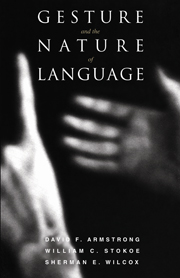Book contents
- Frontmatter
- Contents
- Acknowledgments
- Introduction: language from the body
- 1 The universe of gesture
- 2 The nature of gesture
- 3 Are signed and spoken languages differently organized?
- 4 Is language modular?
- 5 Do we have a genetically programmed drive to acquire language?
- 6 Language from the body politic
- 7 The origin of syntax: gesture as name and relation
- 8 Language from the body: an evolutionary perspective
- References
- Author index
- Subject index
7 - The origin of syntax: gesture as name and relation
Published online by Cambridge University Press: 05 June 2012
- Frontmatter
- Contents
- Acknowledgments
- Introduction: language from the body
- 1 The universe of gesture
- 2 The nature of gesture
- 3 Are signed and spoken languages differently organized?
- 4 Is language modular?
- 5 Do we have a genetically programmed drive to acquire language?
- 6 Language from the body politic
- 7 The origin of syntax: gesture as name and relation
- 8 Language from the body: an evolutionary perspective
- References
- Author index
- Subject index
Summary
The evidence … indicates that language could not have developed gradually out of protolanguage, and it suggests that no intermediate form exists. If this is so, then syntax must have emerged in one piece, at one time – the most likely cause being some kind of mutation that affected the organization of the brain. Since mutations are due to change, and beneficial ones are rare, it is implausible to hypothesize more than one such mutation.
Derek Bickerton, Language and speciesTHE SYSTEM OF LANGUAGE
It should be clear by now that we will argue against this hypothesis by Bickerton, an hypothesis which flows from transformational linguistic theory; although, in Chapter 8, we will discuss a candidate gene that has recently been proposed as a possible basis for this brain reorganization, as well as changes in the vocal tract (Greenhood, 1992). We propose, instead, that there are intermediate stages between non-syntactic communication and fully syntactic language. The essential vehicle of communication that must be understood according to our argument is the iconic, visible gesture. The key problem, according to Bickerton, is getting from nonhierarchical strings of symbols to hierarchical structures, with embedding of phrases. We have already presented alternatives to the rules and representations system that this implies (Chapter 5). Here we will argue that the key to building syntax incrementally is the discovery of relationships within symbols, and that embryo sentences are already inherent in simple visible gestures.
- Type
- Chapter
- Information
- Gesture and the Nature of Language , pp. 161 - 197Publisher: Cambridge University PressPrint publication year: 1995



